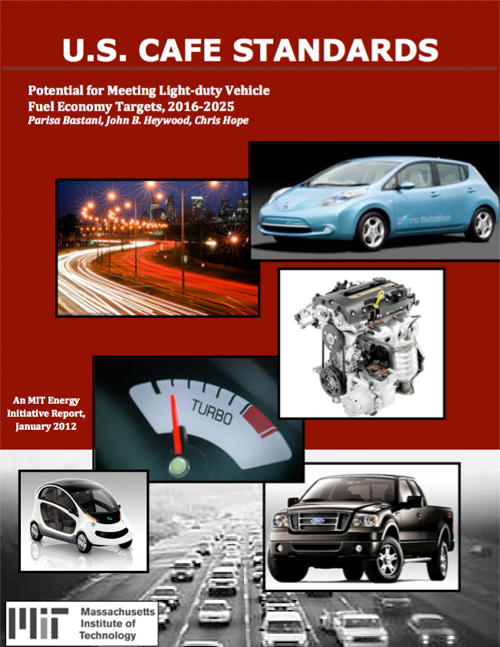
U.S. CAFE Standards
Potential for Meeting Light-duty Vehicle Fuel Economy Target, 2016-2025
Abstract
We are submitting this Report titled U.S. CAFE Standards: Potential for Meeting Light-duty Vehicle Fuel Economy Targets, 2016-2025 which we have prepared as our response to the joint NHTSA and EPA proposal for extending the U.S. National Program to further improve light-duty vehicle fuel economy and reduce greenhouse gas emissions, for model years 2017 through 2025. It is based on our research of the past year or so, using a forward-looking stochastic fleet assessment model for analyzing the impact of uncertainly on projected future light-duty vehicle fuel use and greenhouse gas emissions (Bastani, P. Heywood, J.B., Hope, C., SAE paper 2012-01-0647, SAE 2012 World Congress, Detroit, MI), with appropriate assumptions for future average car and light-truck operating characteristics and sales volumes.
In our Report, we have shown that the proposed regulations are highly demanding on both technological and market deployment fronts. Strong coordinated policies in addition to stringent CAFE requirements will thus be required to incentivize aggressive development of greatly improved propulsion system and vehicle technologies as well as the rapid market penetration of that technology, along with increasing deployment of alternative vehicles and fuels, into actual use.
We quantitatively analyze three different scenarios. First, we define an operational space within which we evaluate specific scenarios, using evolving upper and lower bounds on the assumed vehicle characteristics, sales volumes of each major technology, and anticipated travel demand. Within this context we show that:
- With our plausible yet ambitious scenario, (see Bastani, P., Heywood, J.B., & Hope, C., Transportation Research Part A, vol. 46, pp. 517-548, 2012) the likelihood of exceeding the 2016 fleet average targets is moderate for passenger cars, but very low for the combined car plus light-truck new vehicle fleets. The prospects of meeting the 2025 targets with this scenario are extremely low.
- With a more optimistic scenario where, for example, vehicle performance remains unchanged (a significant departure from the history of the last two or so decades), the prospects for meeting the 2016 fleet targets with passenger cars rises to some 50% but for the combined cars and light trucks sales are still only a few percent. The potential for the combined car and light truck sales meeting the 2025 targets on time is very low indeed.
- With the proposed EPA/DOT preferred alternative scenario, a more optimistic scenario, as spelled out in the proposed rule making, the prospects for meeting these targets are better: some 20% for the combined car and light truck fleet meeting the 2016 CAFE fleet-average targets, but still only about 15% for the 2025 targets.
We hope that this probabilistic analysis with the logic behind its assumptions carefully explained (and referenced), with its detailed results and findings, will prove useful to you in your deliberations of these proposed CAFE requirements.
Parisa Bastani, John Heywood, Chris Hope
University of Cambridge and MIT